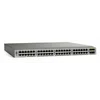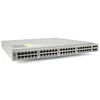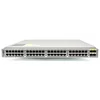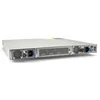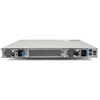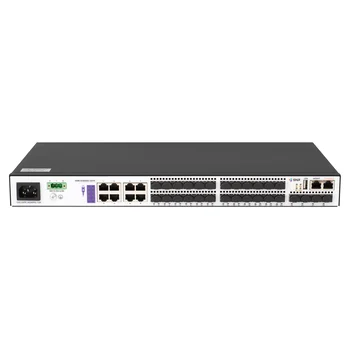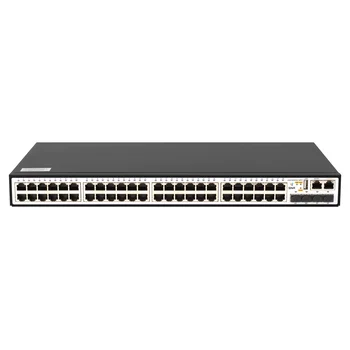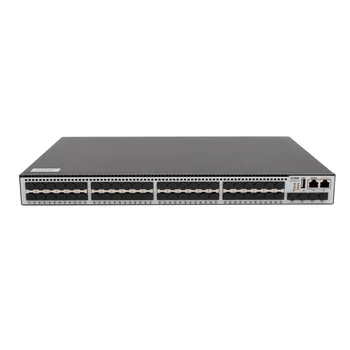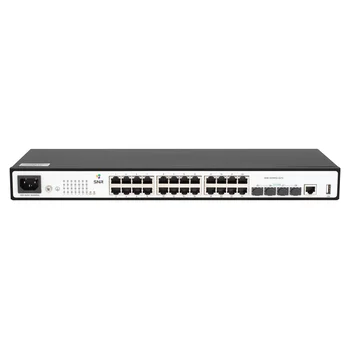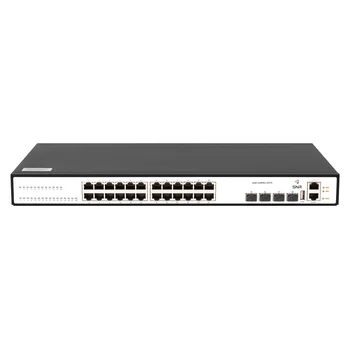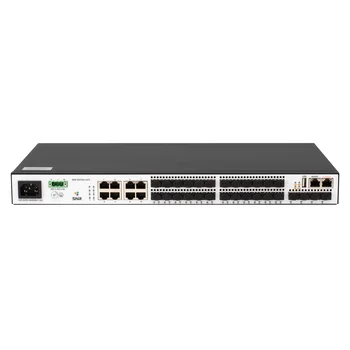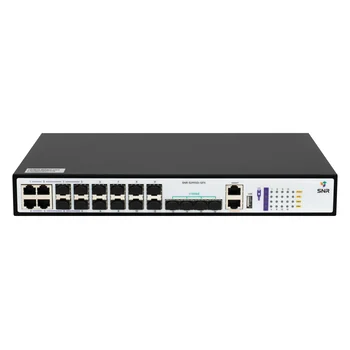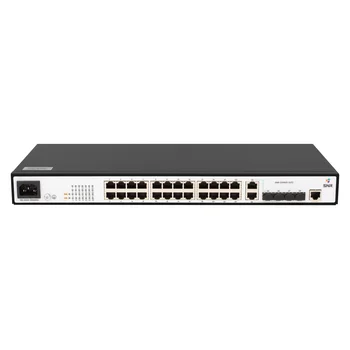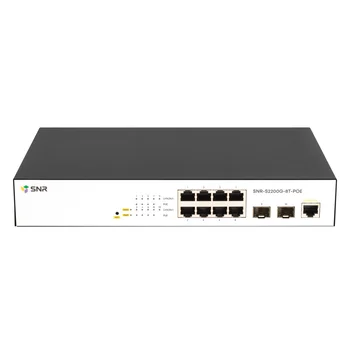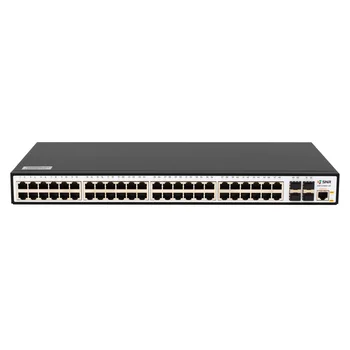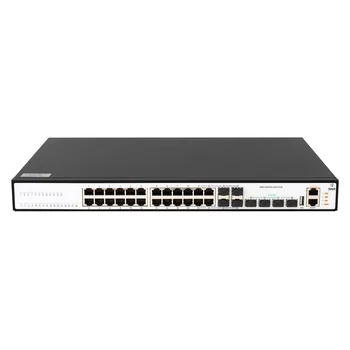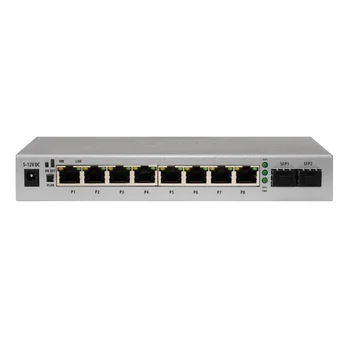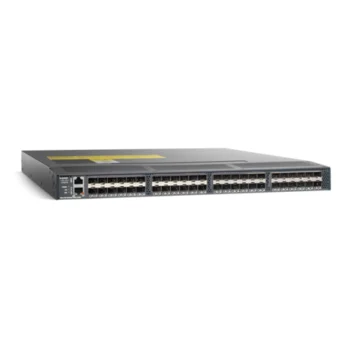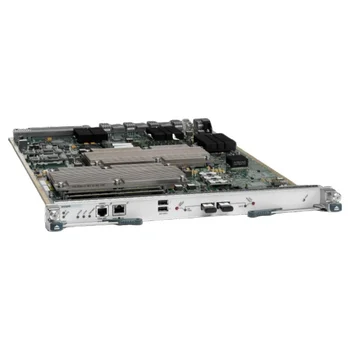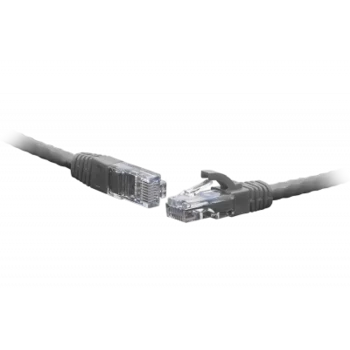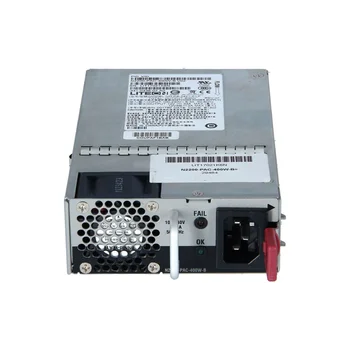| Product specifications Physical - 1RU fixed form-factor switch
- 48 10/100/1000-Mbps RJ-45 ports
- 4 1/10 Gbps SFP+ uplink ports
- 2 redundant power supplies
- 1 fan tray with redundant fans
- 1 I/O module with management, console, and USB flash memory ports
Performance - 176-Gbps switching capacity
- Forwarding rate of 132 mpps
- Line-rate traffic throughput (both Layer 2 and 3) on all ports
- Configurable Maximum Transmission Units (MTUs) of up to 9216 bytes (jumbo frames)
Hardware tables and scalability - MAC addresses: 128,000
- Number of VLANS: 4096
- Spanning-tree instances: RSTP: 512, MSTP: 64
- ACL entries: 2000 ingress, 1000 egress
- Routing table: 16,000 prefixes and 16,000 host entries, 8000 multicast routes
- Number of EtherChannels: 52 (with vPC)
- Number of ports per EtherChannel: 16
- Buffers 9 MB shared
- Boot flash memory 2 GB
Power - Number of power supplies: 2 (redundant)
- Typical operating power: 120 watts (W) (48p of 1G and 4p of 10G/SR at 100% load, with 2 Power Supply Units [PSUs])
- Maximum power: 124W
- AC PSUs: Input voltage 100 to 240 VAC, Frequency 50 to 60 Hz, Efficiency 89 to 91% at 220V
- DC PSUs: Input voltage -40 to -72 VDC, Maximum current 33A, Efficiency 85 to 88%
- Typical heat dissipation: 409 BTU/hr (48p of 1G and 4p of 10G/SR at 100% load, with 2 PSUs)
- Maximum heat dissipation: 423 BTU/hr
Cooling - Forward and reversed airflow schemes
- Forward airflow: Port-side exhaust (air enters through fan-tray and power supplies and exits through ports)
- Reversed airflow: Port-side intake (air enters through ports and exits through fan tray and power supplies)
- Single fan tray with redundant fans
- Hot swappable (must swap within 1 minute)
Sound - Measured sound power (maximum):
Fan speed: 40% duty cycle - 63.9 dBA
Fan speed: 60% duty cycle - 64.7 dBA
Fan speed: 100% duty cycle - 66.4 dBA Environment - Dimensions (height x width x depth): 1.72 x 17.3 x 19.7 in. (4.4 x 43.9 x 50.5 cm)
- Weight 20.5 lb (9.3 kg)
- Operating temperature 32 to 104°F (0 to 40°C)
- Storage temperature -40 to 158°F (-40 to 70°C)
- Operating relative humidity: 10 to 85% noncondensing Up to 5 days at maximum (85%) humidity, Recommend ASHRAE data center environment
- Storage relative humidity: 5 to 95% noncondensing
- Altitude: to 10,000 ft (0 to 3000m)
| Software features Layer 2 - Layer 2 switch ports and VLAN trunks
- IEEE 802.1Q VLAN encapsulation
- Support for up to 4096 VLANs
- Rapid per-VLAN Spanning Tree Plus (PVRST+) (IEEE 802.1w compatible)
- MSTP (IEEE 802.1s): 64 instances
- Spanning Tree PortFast
- Spanning Tree Root Guard
- Spanning Tree Bridge Assurance
- vPC
- Cisco EtherChannel technology (up to 16 ports per EtherChannel)
- LACP: IEEE 802.3ad
- Advanced PortChannel hashing based on Layer 2, 3, and 4 information
- Jumbo frames on all ports (up to 9216 bytes)
- Storm control (unicast, multicast, and broadcast)
- PVLANs
Layer 3 - Layer 3 interfaces: Routed ports on interfaces, Switch Virtual Interfaces (SVIs), PortChannels, and subinterfaces (total = 1024)
- 32-way ECMP
- 2000 ingress and 1000 egress ACL entries
- Routing protocols: Static, RIP v2, EIGRP, OSPFv2, and BGP
- Bidirectional Flow Detection (BFD) for BGP
- HSRP and VRRP
- ACL: Routed ACL with Layer 3 and 4 options to match ingress and egress ACLs
- VRF: VRF-lite (IP VPN), VRF-aware unicast (BGP, OSPF, and RIP), and VRF-aware multicast
- uRPF with ACL; strict and loose modes
- Jumbo frame support (up to 9216 bytes)
Multicast - Multicast: PIM-SM Version 2 and SSM
- Bootstrap Router (BSR), Automatic Rendezvous Point (Auto-RP), and Static RP
- MSDP and Anycast-RP
- Internet Group Management Protocol (IGMP) Versions 2, and 3
Quality of Service (QoS) - Layer 2 IEEE 802.1p (Class of Service [CoS])
- 8 hardware queues per port
- Per-port QoS configuration
- CoS trust
- Port-based CoS assignment
- Modular QoS CLI (MQC) compliance
- ACL-based QoS classification (Layers 2, 3, and 4)
- MQC CoS marking
- Differentiated Services Code Point (DSCP) marking
- Weighted Random Early Detection (WRED)
- CoS-based egress queuing
- Egress strict-priority queuing
- Egress port-based scheduling: Weighted Round-Robin (WRR)
- Explicit Congestion Notification (ECN)
Security - Ingress ACLs (standard and extended) on Ethernet
- Standard and extended Layer 3 to 4 ACLs: IPv4, Internet Control Message Protocol (ICMP), TCP, User Datagram Protocol (UDP), etc.
- VLAN-based ACLs (VACLs)
- Port-based ACLs (PACLs)
- Named ACLs
- ACLs on virtual terminals (vtys)
- DHCP snooping with Option 82
- Port number in DHCP Option 82
- DHCP relay
- Dynamic Address Resolution Protocol (ARP) inspection
- CoPP
Cisco Nexus Data Broker - Topology support for tap and SPAN aggregation
- Support for QinQ to tag input source tap and SPAN ports
- Traffic load balancing to multiple monitoring tools
- Traffic filtering based on Layer 1 through Layer 4 header information
- Traffic replication and forwarding to multiple monitoring tools
- Robust RBAC
- Northbound Representational State Transfer (REST) API for all programmability support
Management - Switch management using 10/100/1000-Mbps management or console ports
- CLI-based console to provide detailed out-of-band management
- In-band switch management
- Locator and beacon LEDs
- Port-based locator and beacon LEDs
- Configuration rollback
- SSHv2
- Telnet
- AAA
- AAA with RBAC
- RADIUS
- TACACS+
- Syslog
- Syslog generation on system resources (for example, FIB tables)
- Embedded packet analyzer
- SNMP v1, v2, and v3
- Enhanced SNMP MIB support
- XML (NETCONF) support
- Remote Monitoring (RMON)
- Advanced Encryption Standard (AES) for management traffic
- Unified username and passwords across CLI and SNMP
- Microsoft Challenge Handshake Authentication Protocol (MS-CHAP)
- Digital certificates for management between switch and RADIUS server
- Cisco Discovery Protocol Versions 1 and 2
- RBAC
- Cisco Switched Port Analyzer (SPAN) on physical, PortChannel and VLAN interfaces
- Encapsulated Remote Switched Port Analyzer (ERSPAN)
- Ingress and egress packet counters per interface
- PTP (IEEE1588) boundary clock
- Network Time Protocol (NTP)
- Cisco OHMS
- Comprehensive bootup diagnostic tests
- Cisco Call Home
- Cisco DCNM
- Advanced buffer monitoring
|
